Inhibiting the nucleation of amyloid structure in a huntingtin fragment by targeting α-helix-rich oligomeric intermediates
- PMID: 22178478
- PMCID: PMC3267848
- DOI: 10.1016/j.jmb.2011.12.011
Inhibiting the nucleation of amyloid structure in a huntingtin fragment by targeting α-helix-rich oligomeric intermediates
Abstract
Although oligomeric intermediates are transiently formed in almost all known amyloid assembly reactions, their mechanistic roles are poorly understood. Recently, we demonstrated a critical role for the 17-amino-acid N-terminus (htt(NT) segment) of huntingtin (htt) in the oligomer-mediated amyloid assembly of htt N-terminal fragments. In this mechanism, the htt(NT) segment forms the α-helix-rich core of the oligomers, leaving much of the polyglutamine (polyQ) segment disordered and solvent-exposed. Nucleation of amyloid structure occurs within this local high concentration of disordered polyQ. Here we demonstrate the kinetic importance of htt(NT) self-assembly by describing inhibitory htt(NT)-containing peptides that appear to work by targeting nucleation within the oligomer fraction. These molecules inhibit amyloid nucleation by forming mixed oligomers with the htt(NT) domains of polyQ-containing htt N-terminal fragments. In one class of inhibitors, nucleation is passively suppressed due to the reduced local concentration of polyQ within the mixed oligomer. In the other class, nucleation is actively suppressed by a proline-rich polyQ segment covalently attached to htt(NT). Studies with D-amino acid and scrambled sequence versions of htt(NT) suggest that inhibition activity is strongly linked to the propensity of inhibitory peptides to make amphipathic α-helices. Htt(NT) derivatives with C-terminal cell-penetrating peptide segments also exhibit excellent inhibitory activity. The htt(NT)-based peptides described here, especially those with protease-resistant d-amino acids and/or with cell-penetrating sequences, may prove useful as lead therapeutics for inhibiting the nucleation of amyloid formation in Huntington's disease.
Copyright © 2011 Elsevier Ltd. All rights reserved.
Figures

 ); 25.2 μM SWQ37P10K2 (
); 25.2 μM SWQ37P10K2 (
 ); 25.6 μM K2Q35P10K2 (▴); 7.5 μM K2Q41K2 alone (
); 25.6 μM K2Q35P10K2 (▴); 7.5 μM K2Q41K2 alone (
 ); and 7.0 μM K2Q41K2 plus 17.4 μM httNT (
); and 7.0 μM K2Q41K2 plus 17.4 μM httNT (
 ). (b) Aggregation of 18.8 μM of the peptide ESLKSF-Q35-PPPSKETAAAKFERQHMDS incubated alone (●) or with 29.6 μM httNT (
). (b) Aggregation of 18.8 μM of the peptide ESLKSF-Q35-PPPSKETAAAKFERQHMDS incubated alone (●) or with 29.6 μM httNT (
 ).
).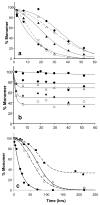



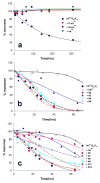
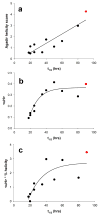

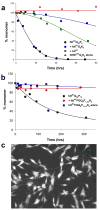
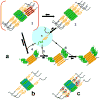
Similar articles
-
Slow amyloid nucleation via α-helix-rich oligomeric intermediates in short polyglutamine-containing huntingtin fragments.J Mol Biol. 2012 Feb 3;415(5):881-99. doi: 10.1016/j.jmb.2011.12.010. Epub 2011 Dec 9. J Mol Biol. 2012. PMID: 22178474 Free PMC article.
-
Kinetically competing huntingtin aggregation pathways control amyloid polymorphism and properties.Biochemistry. 2012 Apr 3;51(13):2706-16. doi: 10.1021/bi3000929. Epub 2012 Mar 20. Biochemistry. 2012. PMID: 22432740 Free PMC article.
-
Polyglutamine amyloid core boundaries and flanking domain dynamics in huntingtin fragment fibrils determined by solid-state nuclear magnetic resonance.Biochemistry. 2014 Oct 28;53(42):6653-66. doi: 10.1021/bi501010q. Epub 2014 Oct 16. Biochemistry. 2014. PMID: 25280367 Free PMC article.
-
The emerging role of the first 17 amino acids of huntingtin in Huntington's disease.Biomol Concepts. 2015 Mar;6(1):33-46. doi: 10.1515/bmc-2015-0001. Biomol Concepts. 2015. PMID: 25741791 Free PMC article. Review.
-
The hunt for huntingtin function: interaction partners tell many different stories.Trends Biochem Sci. 2003 Aug;28(8):425-33. doi: 10.1016/S0968-0004(03)00168-3. Trends Biochem Sci. 2003. PMID: 12932731 Review.
Cited by
-
Nucleation Inhibition of Huntingtin Protein (htt) by Polyproline PPII Helices: A Potential Interaction with the N-Terminal α-Helical Region of Htt.Biochemistry. 2020 Feb 4;59(4):436-449. doi: 10.1021/acs.biochem.9b00689. Epub 2019 Dec 20. Biochemistry. 2020. PMID: 31814404 Free PMC article.
-
Molecular interaction between the chaperone Hsc70 and the N-terminal flank of huntingtin exon 1 modulates aggregation.J Biol Chem. 2015 Jan 30;290(5):2560-76. doi: 10.1074/jbc.M114.603332. Epub 2014 Dec 10. J Biol Chem. 2015. PMID: 25505179 Free PMC article.
-
Transient interdomain interactions modulate the monomeric structural ensemble and self-assembly of Huntingtin Exon 1.bioRxiv [Preprint]. 2024 Dec 11:2024.05.03.592468. doi: 10.1101/2024.05.03.592468. bioRxiv. 2024. Update in: Adv Sci (Weinh). 2025 Jul;12(27):e2501462. doi: 10.1002/advs.202501462. PMID: 38766024 Free PMC article. Updated. Preprint.
-
Huntingtin protein interactions altered by polyglutamine expansion as determined by quantitative proteomic analysis.Cell Cycle. 2012 May 15;11(10):2006-21. doi: 10.4161/cc.20423. Epub 2012 May 15. Cell Cycle. 2012. PMID: 22580459 Free PMC article.
-
Polyglutamine Aggregation in Huntington Disease: Does Structure Determine Toxicity?Mol Neurobiol. 2015 Dec;52(3):1297-1314. doi: 10.1007/s12035-014-8932-1. Epub 2014 Oct 22. Mol Neurobiol. 2015. PMID: 25336039 Review.
References
-
- Zuccato C, Valenza M, Cattaneo E. Molecular mechanisms and potential therapeutical targets in Huntington’s disease. Physiol Rev. 2010;90:905–81. - PubMed
-
- Wilburn B, Rudnicki DD, Zhao J, Weitz TM, Cheng Y, Gu XF, Greiner E, Park CS, Wang N, Sopher BL, La Spada AR, Osmand A, Margolis RL, Sun YE, Yang XW. An antisense CAG repeat transcript at JPH3 locus mediates expanded polyglutamine protein toxicity in Huntington’s disease-like 2 mice. Neuron. 2011;70:427–440. - PMC - PubMed
-
- Bates GP, Benn C. The polyglutamine diseases. In: Bates GP, Harper PS, Jones L, editors. Huntington’s Disease. Oxford University Press; Oxford, U.K: 2002. pp. 429–472.
-
- Sathasivam K, Lane A, Legleiter J, Warley A, Woodman B, Finkbeiner S, Paganetti P, Muchowski PJ, Wilson S, Bates GP. Identical oligomeric and fibrillar structures captured from the brains of R6/2 and knock-in mouse models of Huntington’s disease. Human Molecular Genetics. 2010;19:65–78. - PMC - PubMed
Publication types
MeSH terms
Substances
Grants and funding
LinkOut - more resources
Full Text Sources
Other Literature Sources
Research Materials

